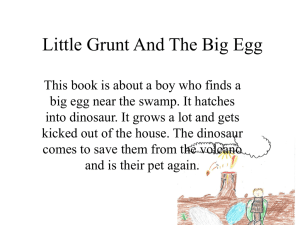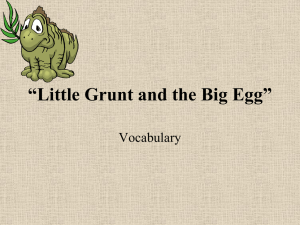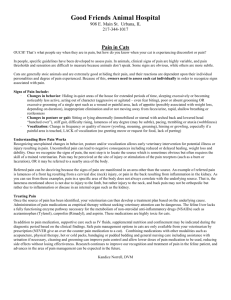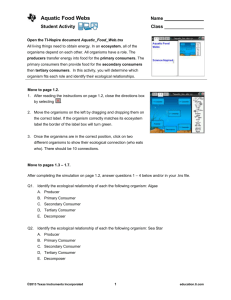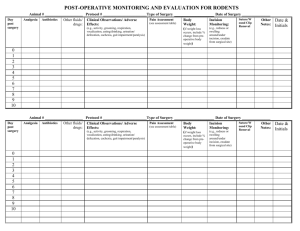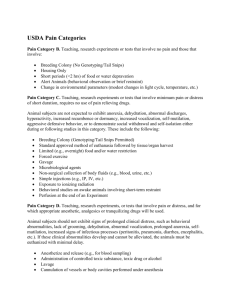Supplemental Material (3) for Nadhurou et al. (Nadhurou B., Gamba
advertisement
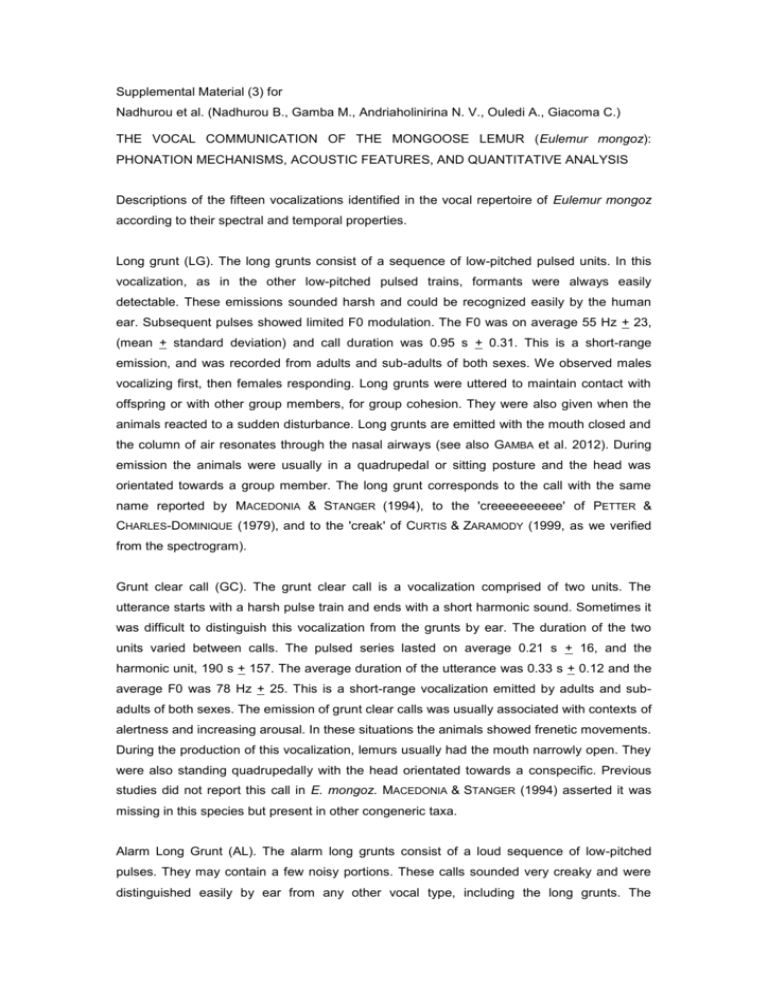
Supplemental Material (3) for Nadhurou et al. (Nadhurou B., Gamba M., Andriaholinirina N. V., Ouledi A., Giacoma C.) THE VOCAL COMMUNICATION OF THE MONGOOSE LEMUR (Eulemur mongoz): PHONATION MECHANISMS, ACOUSTIC FEATURES, AND QUANTITATIVE ANALYSIS Descriptions of the fifteen vocalizations identified in the vocal repertoire of Eulemur mongoz according to their spectral and temporal properties. Long grunt (LG). The long grunts consist of a sequence of low-pitched pulsed units. In this vocalization, as in the other low-pitched pulsed trains, formants were always easily detectable. These emissions sounded harsh and could be recognized easily by the human ear. Subsequent pulses showed limited F0 modulation. The F0 was on average 55 Hz + 23, (mean + standard deviation) and call duration was 0.95 s + 0.31. This is a short-range emission, and was recorded from adults and sub-adults of both sexes. We observed males vocalizing first, then females responding. Long grunts were uttered to maintain contact with offspring or with other group members, for group cohesion. They were also given when the animals reacted to a sudden disturbance. Long grunts are emitted with the mouth closed and the column of air resonates through the nasal airways (see also GAMBA et al. 2012). During emission the animals were usually in a quadrupedal or sitting posture and the head was orientated towards a group member. The long grunt corresponds to the call with the same name reported by MACEDONIA & STANGER (1994), to the 'creeeeeeeeee' of PETTER & CHARLES-DOMINIQUE (1979), and to the 'creak' of CURTIS & ZARAMODY (1999, as we verified from the spectrogram). Grunt clear call (GC). The grunt clear call is a vocalization comprised of two units. The utterance starts with a harsh pulse train and ends with a short harmonic sound. Sometimes it was difficult to distinguish this vocalization from the grunts by ear. The duration of the two units varied between calls. The pulsed series lasted on average 0.21 s + 16, and the harmonic unit, 190 s + 157. The average duration of the utterance was 0.33 s + 0.12 and the average F0 was 78 Hz + 25. This is a short-range vocalization emitted by adults and subadults of both sexes. The emission of grunt clear calls was usually associated with contexts of alertness and increasing arousal. In these situations the animals showed frenetic movements. During the production of this vocalization, lemurs usually had the mouth narrowly open. They were also standing quadrupedally with the head orientated towards a conspecific. Previous studies did not report this call in E. mongoz. MACEDONIA & STANGER (1994) asserted it was missing in this species but present in other congeneric taxa. Alarm Long Grunt (AL). The alarm long grunts consist of a loud sequence of low-pitched pulses. They may contain a few noisy portions. These calls sounded very creaky and were distinguished easily by ear from any other vocal type, including the long grunts. The vocalization lasted on average 0.50 s + 0.17 and the average F0 was 78 Hz + 21. These long-range calls were emitted by adult and sub-adult males, seldom by the adult females. Alarm long grunts were uttered in the presence of potential terrestrial predators (including humans), and were also given during encounters with congeneric groups. They were always given with open mouth, in contrast to the other pulsed trains, with the animal in a quadrupedal position and its head directed towards the potential predator or a member of another group. The call was identified in other publications as the 'creaking door' (TATTERSALL & SUSSMAN 1975), the 'greeee' (PETTER & CHARLES-DOMINIQUE 1979), the 'long creak' (CURTIS & ZARAMODY 1999) and the open mouth grunt (MACEDONIA & STANGER 1994). Alarm Long Grunt Clear Call (AC). Alarm long grunt clear calls consist of a loud pulsed train ending in a harmonic sweep. They may show noisy portions. This vocal type sounded creaky, and could easily be distinguished from other vocalizations by ear. They showed an average F0 of 84 Hz +19 and a duration of 0.68 s + 0.14. Adults and sub-adults of both sexes emitted these long-range calls. Alarm long grunt clear calls were usually given during interactions with other species and in the presence of a potential terrestrial predator, in situations characterized by high arousal. They were always given with open mouth, but the degree of mouth opening decreased towards the end of the emission. During the emission of these vocalizations the animals were usually in a quadrupedal stance. This vocalization probably corresponds to the 'closed/open mouth grunts' reported by MACEDONIA AND STANGER (1994). Grunt (GR). Grunts are emitted as a short train of low-pitched pulses which can be structurally variable. These calls are very common, and easily recognized by the human ear. The average duration of a grunt was 0.10 s + 0.03, and the average F0 is 61 Hz + 15. Adults and sub-adults of both sexes uttered this short-range vocalization in various contexts, such as group cohesion, alertness and territorial defence. They are widespread in all Eulemur species (GAMBA & GIACOMA 2005; 2007). Grunts were frequently produced when lemurs travelled and in cases of mild disturbance. Males uttered grunts when defending their groups in the presence of humans, who they threatened to attack. Grunts are always given with the mouth closed and the air passes through the nasal airways. Their emission was not associated with a specific posture. Sometimes we observed head and tail movements. Grunts were referred to as 'medium-intensity alarm calls' by PETTER & CHARLES-DOMINIQUE (1979). Grunt hoot (GH). The grunt hoot is a noisy grunt, involving a rapid expulsion of air in its final part. They sound harsh, and can easily be distinguished by ear from the other vocal types. Their average F0 was 43 Hz + 23 and their duration, 0.29 s + 0.14. Adults and sub-adults of both sexes uttered this short-range vocalization when alerted, or when they were moving excitedly during high arousal. These sounds are uttered with the mouth closed from a quadrupedal standing position. During production of this call, the air apparently passes though the nasal airways. This vocal type probably corresponds to the 'explosive grunt' reported by TATTERSALL & SUSSMAN (1975), to the 'grunt sneeze' of CURTIS & ZARAMODY (1999), and to the 'click-grunt' described by ANDREW (1963). Click (CL). Clicks are low amplitude calls of very brief duration (0.02 s + 0.01). They may contain a noisy portion. High quality recordings of clicks allowed us to detect the first four formants. The clicks were audible by humans, and easily distinguishable from the other vocal types. This vocalization is made by very short series of glottal pulses with average F0 of 212 Hz + 19. Clicks were used in short-range communication and given by adults and sub-adults of both sexes when they were alerted (see also MACEDONIA & STANGER 1994), during feeding and possibly to warn conspecifics. They are uttered with the mouth closed, and not associated with a specific posture. Clicks were also reported by MACEDONIA & STANGER (1994) associated with the same context in which we recorded them. They were probably included among the 'medium-intensity alarm calls' of PETTER & CHARLES-DOMINIQUE (1979). Snort (SN). Snorts were produced by a brief, rapid expulsion of air, and usually showed an increasingly broadband structure (Macedonia 1994) and increasing amplitude, resembling human sneezes. They usually showed a detectable pitch. The snort is recognizable by the human ear but very short emissions can sometimes be confused with clicks. The F0 was 199 Hz + 45 and average duration was 0.03 s + 0.01. Adults and sub-adults of both sexes gave snorts during short-range communication, in situations of moderate to high arousal, when moving hectically or when travelling in the forest. Snorts are uttered with the mouth closed and the expulsion of air occurred through the nasal tract. Snorts were not associated with a specific posture, and were reported by CURTIS & ZARAMODY (1999) and by PETTER & CHARLES-DOMINIQUE (1979). Territorial call (TE). Territorial advertisement calls consisted of a high amplitude harmonic signal with large noisy portions. They can be distinguished by ear from any other vocal type. Their average F0 was 255 Hz + 22, and their average duration was 0.63 s + 0.17. Adult individuals of both sexes uttered territorial calls, which served for long-range communication. We observed mongoose lemurs emitting these vocalizations towards both conspecific and congeneric groups (e.g. Eulemur fulvus and Eulemur rufus), during encounters. The calls were also, although rarely, given in presence of humans, shortly before the animals fled. The production of these vocalizations required articulation, with the degree of mouth opening changing repeatedly during the emission, and the animals usually adopted a quadrupedal stance with the head orientated towards an opponent. The call has previously been described as the 'creeee' (PETTER & CHARLES-DOMINIQUE 1979), the 'terrestrial disturbance/advertisement' (MACEDONIA & STANGER 1994) and the 'screech' (CURTIS & ZARAMODY 1999). Croui-croui (CR). The croui-croui consisted of three repeated units of high amplitude. It is a species-specific call and distinguishable by ear from any other vocal type. Its average duration was 1.34 s + 0.25, with an average F0 of 128 Hz + 8. Adult individuals of both sexes uttered croui-croui calls for long-range communication. This utterance was always recorded around sunset, when the animals were regrouping or moving to their sleeping sites, and probably serves as a territorial advertisement signal exchanged between mongoose lemur groups. During phonation of the croui-croui we observed repeated articulation, with different degrees of mouth opening. During the emission, animals usually adopted a quadrupedal standing posture. Although the call has been heard by CURTIS (pers. comm.), we did not find any corresponding call in previously published work. Hoot (HO). The hoot is a brief harmonic emission of low amplitude and little/scant frequency modulation. Hoots are guttural sounds, distinguishable by ear from the other vocal types, but demand careful listening not to be confused with the grunt hoot. The acoustic analysis showed an average F0 of 306 Hz + 96 and a short duration (0.07 s + 0.03). Hoots were used in short-range communication and were given by adults and sub-adults of both sexes. They were low-level alertness utterances emitted in response to general disturbance, produced with the mouth closed and the emitter in a quadrupedal or sitting position. The hoot (MACEDONIA & STANGER 1994) corresponds to the 'sneeze' of PETTER & CHARLES-DOMINIQUE (1979) and CURTIS & ZARAMODY (1999). Aerial Alarm call (AA). The aerial alarm call consists of a brief harmonic call that may be repeated in short series. It has a harsh sound and can be recognized by ear. The average duration of this rarely recorded call was 0.04 s + 0.02, and it was obviously shorter and structurally different from other Eulemur species alarm vocalizations (GAMBA & GIACOMA 2007). The average F0 was 388 Hz + 122. The aerial alarm was used in short-range communication. We only observed adult males and adult females emitting this call, which was given in response to the presence of potential aerial predators (MACEDONIA & STANGER 1994; B. NADHUROU pers. observation). During the production of aerial alarm calls, the mouth was closed or narrowly open. The animals emitting this call were usually in a crouched position. As it occurred rarely and in a very particular context, this call may correspond to the 'cak' reported by CURTIS & ZARAMODY (1999), which appears to serve a similar function. Tonal call (TC). Tonal calls were usually characterized by several visible harmonics and scant frequency modulation. They can easily be recognized by the human ear. Their average F0 was 581 Hz + 102, with an average duration of 0.12 s + 0.08. Adult individuals of both sexes uttered tonal calls when interacting with conspecifics at short-range, and sub-adults uttered these calls repetitively (e.g. while jumping between the branches of a tree or when the group was travelling long routes (more than 100 m). Tonal calls were also exchanged between mothers and offspring. They appear to be general contact calls, often during travelling, but also during hectic activity. Tonal calls were uttered with the mouth closed or narrowly open, from a sitting position or while moving. The spectrogram and/or the context of emission of tonal calls correspond to those of the 'hon' of PETTER & CHARLES-DOMINIQUE (1979), the 'clear call' of MACEDONIA & STANGER (1994) and the 'hmm' of CURTIS & ZARAMODY (1999). Chatter (CH). The chatter is a low amplitude, highly frequency modulated signal, sometimes very high pitched, and comprising a sequence of sweeping and unsweeping portions. They can sound harsh and are easily recognized by the human ear. Their average duration was 0.36 s + 0.39 and their average F0 was higher than that of any other vocalization in the repertoire (1906 Hz + 307). The chatter was emitted by adults and sub-adults of both sexes, directed at a conspecific, and serves for short-range communication. It was frequently uttered when the animals competed for food or space, often to indicate submissiveness, and followed by displacement of the emitter. Chatters were usually emitted with the mouth open and rapidly articulated. During the production of these calls the emitter's teeth were usually visible. Emitters were crouched or jumping between branches. The context in which the chatter was recorded coincided with that reported for the 'contact-rejection call' of PETTER & CHARLESDOMINIQUE (1979). Scream (SR). Screams are high amplitude, frequency modulated emissions. They are largely harmonic but can show various degrees of noisiness and of frequency modulation. They may consist of sweeping and unsweeping portions. They are raspy and can easily be recognized by ear from any other type. The screams we recorded showed an average F0 of 586 Hz + 128 and a duration of 0.32 s + 0.18. One out of four mongoose lemur females gave this emission during veterinary inspection and manipulation. Screams were also heard in the field during physical fights, which typically included bites. Screams were given with a wide-open mouth and rapid mandibular articulation. The scream corresponds to the 'distress cry' of PETTER & CHARLES-DOMINIQUE (1979), probably corresponds to the 'warble' reported by CURTIS & ZARAMODY (1999), and is spectrographically similar to the 'shriek in fear' of ANDREW (1963).
